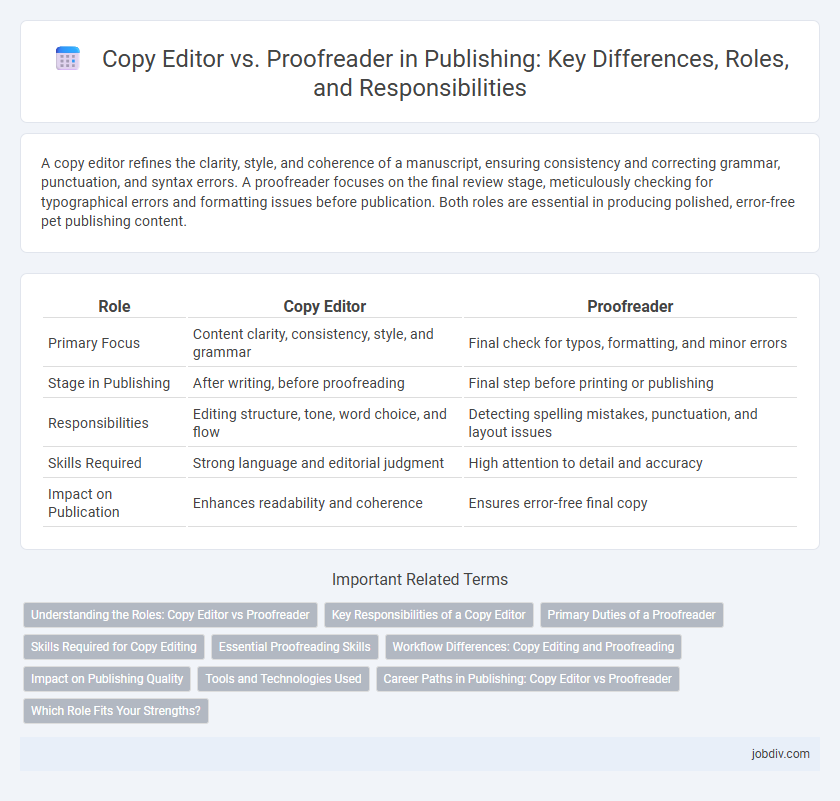A copy editor refines the clarity, style, and coherence of a manuscript, ensuring consistency and correcting grammar, punctuation, and syntax errors. A proofreader focuses on the final review stage, meticulously checking for typographical errors and formatting issues before publication. Both roles are essential in producing polished, error-free pet publishing content.
Table of Comparison
| Role | Copy Editor | Proofreader |
|---|---|---|
| Primary Focus | Content clarity, consistency, style, and grammar | Final check for typos, formatting, and minor errors |
| Stage in Publishing | After writing, before proofreading | Final step before printing or publishing |
| Responsibilities | Editing structure, tone, word choice, and flow | Detecting spelling mistakes, punctuation, and layout issues |
| Skills Required | Strong language and editorial judgment | High attention to detail and accuracy |
| Impact on Publication | Enhances readability and coherence | Ensures error-free final copy |
Understanding the Roles: Copy Editor vs Proofreader
Copy editors refine manuscripts by enhancing clarity, consistency, grammar, and style, ensuring the text aligns with publication standards before layout. Proofreaders conduct the final review focused on catching typographical errors, formatting issues, and minor mistakes in the near-final version. Understanding the distinct responsibilities of copy editors versus proofreaders helps streamline the publishing workflow and guarantees a polished end product.
Key Responsibilities of a Copy Editor
A copy editor ensures the accuracy, clarity, and consistency of a manuscript by correcting grammatical errors, improving sentence structure, and verifying facts. They also maintain style guide adherence and enhance overall readability while checking for logical flow and coherence. Unlike proofreaders, copy editors engage deeply with the content to refine tone, voice, and formatting before the final proofing stage.
Primary Duties of a Proofreader
Proofreaders focus on identifying and correcting surface-level errors such as typos, spelling mistakes, punctuation errors, and formatting inconsistencies in the final draft of a manuscript. Their primary duty is to ensure the text is error-free and ready for publication by conducting a meticulous line-by-line review. Unlike copy editors, proofreaders do not alter content or structure but concentrate solely on polishing the final product for clarity and accuracy.
Skills Required for Copy Editing
Copy editing requires strong language proficiency, attention to detail, and a thorough understanding of grammar, style guides, and consistency in tone. Expertise in fact-checking and improving sentence structure is essential to enhance clarity and readability while maintaining the author's voice. Proficiency in using editing software and collaboration skills with writers and other editorial team members also contribute to effective copy editing.
Essential Proofreading Skills
Essential proofreading skills include a keen eye for typographical errors, grammatical mistakes, and punctuation inconsistencies, ensuring the final manuscript is polished and error-free. Proofreaders must also possess strong attention to detail and a solid understanding of language conventions to detect subtle discrepancies that affect readability. Unlike copy editors who make substantive content improvements, proofreaders focus primarily on surface-level accuracy and clarity before publication.
Workflow Differences: Copy Editing and Proofreading
Copy editors refine manuscript structure, clarity, and consistency by addressing grammar, syntax, and style to ensure alignment with publication standards. Proofreaders perform the final quality check, identifying minor typographical errors, formatting inconsistencies, and overlooked mistakes before publication. The workflow positions copy editing earlier to enhance content accuracy, while proofreading serves as the concluding step to guarantee polished, error-free output.
Impact on Publishing Quality
Copy editors enhance publishing quality by ensuring content clarity, consistency, and adherence to style guides, significantly reducing errors in grammar, punctuation, and factual accuracy. Proofreaders provide a final quality check, identifying typographical mistakes and formatting issues that can undermine reader experience and credibility. Together, their roles maintain high editorial standards, boosting the publication's professionalism and trustworthiness.
Tools and Technologies Used
Copy editors utilize advanced editing software like Adobe InCopy and Grammarly to enhance content structure, consistency, and style, ensuring alignment with publishing guidelines. Proofreaders often rely on digital proofreading tools such as PerfectIt, Microsoft Word Track Changes, and specialized OCR software to detect typographical errors, formatting issues, and minor textual discrepancies. Both roles increasingly incorporate AI-driven platforms and cloud-based collaboration tools to streamline workflows and maintain high-quality manuscript production.
Career Paths in Publishing: Copy Editor vs Proofreader
Copy editors in publishing focus on enhancing content clarity, grammar, and style, often collaborating closely with authors and editors to refine manuscripts before layout. Proofreaders specialize in the final quality check, meticulously identifying typographical errors and formatting inconsistencies after typesetting to ensure publish-ready material. Career paths diverge as copy editors typically require strong language skills and editorial judgment, while proofreaders excel in attention to detail and consistency at the end of the publication process.
Which Role Fits Your Strengths?
Copy editors excel in refining content for clarity, consistency, and style, making them ideal for individuals with strong language skills and attention to detail. Proofreaders specialize in catching typographical errors and formatting inconsistencies, suited for those who have a keen eye for perfection and accuracy. Assessing your strengths in language mechanics versus meticulous error detection helps determine whether a copy editor or proofreader role aligns best with your abilities in the publishing process.
Copy Editor vs Proofreader Infographic

 jobdiv.com
jobdiv.com